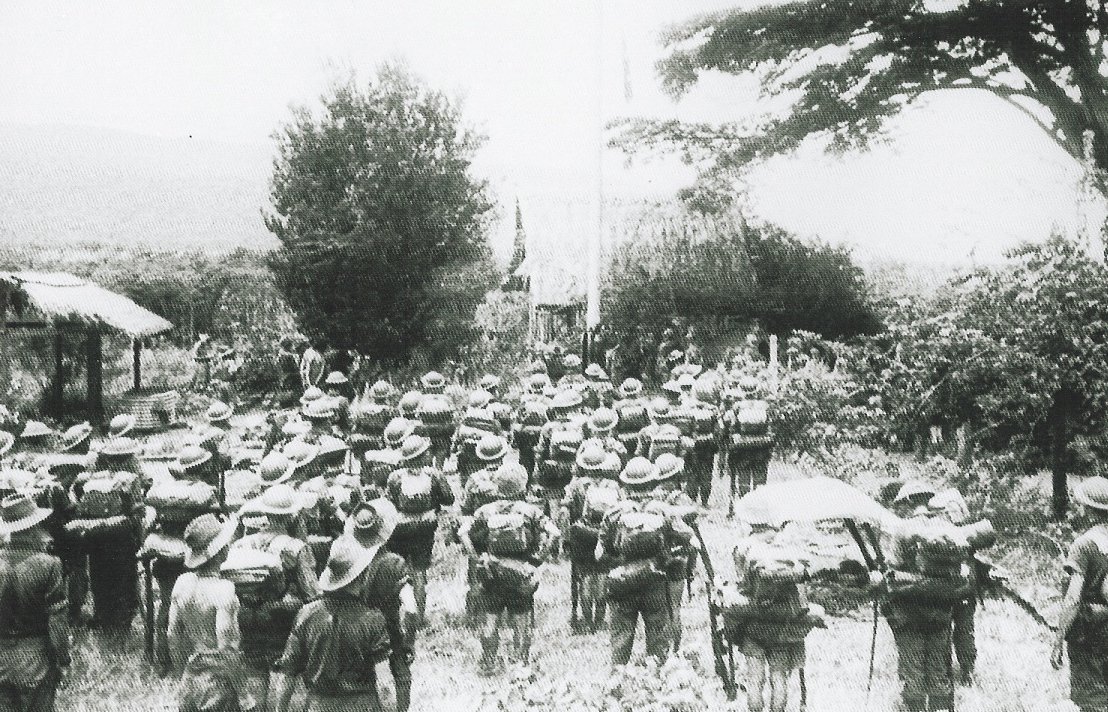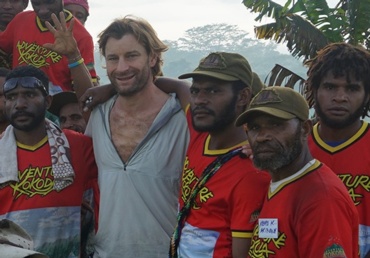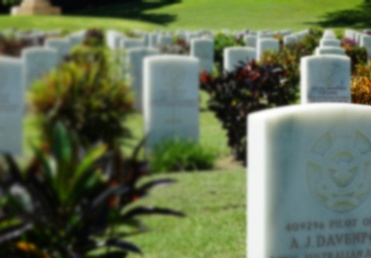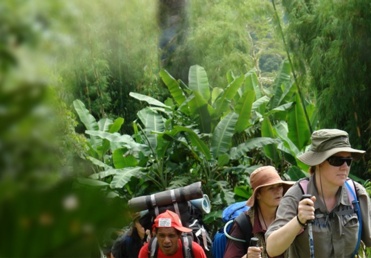Kokoda Day
The day they raised the Australian flag at Kokoda
Australia was unprepared for the war in the Pacific in 1942. Our faith in ‘great and powerful friends’ coming to our aid in the event of Japan entering the war was shattered with the sinking of HMAS Prince of Wales and HMAS Repulse near Singapore on 10 December 1941 and the secret deal struck by UK Prime Minister Winston Churchill and American President Franklin Roosevelt for American aid to be directed to the European theatre of operations at the expense of the South West Pacific.
The defence of Australia and its mandated territory of New Guinea was dependent on untrained militia forces and a small band of New Guinea Rifles as our experienced AIF units were returning from Europe to meet the new threat.
Resources were so scarce in New Guinea that young males were forcibly recruited to support the war effort. Many of these men from remote mountain villagers had no idea of the war and were conscripted against their will. They were told that men from Japan were the enemy. For many of these men other villagers living in remote tribal lands were also considered ‘enemy’. One can only imagine the fear and uncertainty they felt as they were forcibly marched away from their families and clans.
They were designated as Carriers but were to become known as ‘fuzzy-wuzzy angels’ because of their selfless sacrifice in assisting wounded and sick diggers during the various campaigns.
They carried vital war supplies on their bare shoulders in endless lines over hostile and inhospitable terrain. Modern day trekkers are in awe of their efforts. Without this vital link in the chain of our war effort Japan would have been successful in the conquest of New Guinea.
Today, 71 years after the Pacific War, they are the only link in the chain not to have received any official recognition. Many claim they were not properly paid. None were ever issued with a medal. No day has been set aside to commemorate their service or sacrifice.
It is difficult to understand why successive Australian governments have ignored this important omission.
The recent upsurge in interest in the Kokoda campaign by Australian trekkers indicates there is a strong desire for our wartime links with Papua New Guinea to be recognised. This can be achieved by providing them with an incentive to visit, or revisit the country.
The proclamation of a ‘Kokoda Day’ dedicated to the wartime carriers would provide this incentive.
This paper recommends that November 3rd be officially proclaimed as a day of commemoration for the carriers. This is the day the Australian flag was raised at Kokoda – a ceremony that would never have been possible without the support of the New Guinea Wartime Carriers.
An earlier proposal was approved by the PNG Government National Executive Council however the name was changed to ‘Fuzzy-Wuzzy Angel Day’ in the process. This decision defeated the purpose of the announcement as most Australians do not know anything about ‘fuzzy-wuzzy angels’ until they have visited Papua New Guinea.
In marketing terms the name ‘Kokoda’ is priceless whereas the term ‘fuzzy-wuzzy angel’ only has emotional appeal to those who have already trekked.
Objective
To seek the support of the National Executive Council to proclaim 3rd November as ‘Kokoda Day’ to commemorate the service and sacrifice of the Papua New Guinea wartime carriers.
Background
The PNG Carriers who supported Australian troops during the Pacific have never been properly recognized. Some were never paid and none ever received a medal for their service.
According to our official history of the war in the Pacific by Dudley McCarthy (Australia in the War 1939-1945, p116) the Australian New Guinea Army Unit (ANGAU) was authorised by the Australian government to provide for:
‘the conscription of whatever native labour might be required by the Services..’
Rates of pay were to be determined and the Senior Military Officer or District Officer was empowered:
‘to have the natives so employed to enter into a contract with the Australian Government.’
It has been estimated that some 10,000 PNG nationals served as Carriers in support of the Australians during the Kokoda campaign in 1942.
A further 42,000 are estimated to have been indentured to support Australian troops in the Milne Bay and the Buna/Gona campaigns. They were paid 10 shillings per month.
According to wartime journalist, Osmar White[i]:
‘ANGAU contrived a maximum mobilization and use of native labour. At the critical period, its method of conscription was even more arbitrary than German recruiting in the early days. In some villages every able-bodied male over the approximate age of sixteen years was rounded up, transported to the clearing centres, and thence drafted to whatever type of work had priority in the immediate emergency. Brutal disciplinary measures had often to be taken in the field; but when the first and worst crises of invasion were surmounted, ANGAU did what ti could to conserve the life and health of its native levies and to maintain the viability of native communities depleted of 40 or 50 per cent of their able-bodied men. Under military rule, the labourers’ health was more carefully considered and their diet in general better than under private employers before the war. ANGAU was fully aware of the value of native labour and co-operation to the Allied effort.
What is not understood by many is that male villagers indentured for work as Carriers faced two potential enemies – the invading Japanese and traditional clans whose customary land was foreign to them.
During the period 1944 to 1957 approximately 2 million pounds was paid by the Australian Government in compensation for property damage to PNG nationals by the Australian Government. In 1975 PNG gained independence and the PNG Government assumed all legal obligations for compensation of its veteran community.
Unfortunately the PNG Carriers were excluded from benefits under legislation for compensation of PNG nationals who served in the Defence Force. In 1980 they were also deemed to be ineligible for the PNG War Gratuity Scheme for ex-Servicemen.
In 1981 the Australian Government paid $3.25 million to the PNG Government under the Defence (PNG) Retirement Act as a final payment for compensation for Carriers. In 1986 the PNG Government introduced payments of PNGK1,000 for each surviving Carrier. The payments ceased in 1989 and many Carriers claim to have not received any money.
During the 50th anniversary of the Kokoda campaign the issue of payment and compensation for many of the Carriers who claim they were never paid was raised with the Keating Government.
On 21 April 1992 The Australian newspaper reported that returned servicemen in PNG had called on the Australian Government to pay hundreds of local war veterans who helped Australian troops during the Kokoda campaign. According to the report:
“The President of the PNG Returned Services League, Mr Wally Lussick, said Australia had sent about $3.5 million to PNG to help compensate local war veterans in the early 1980s, but much of the money had gone to the wrong people and a large group of carriers missed out.
“Mr Lussick said much of the money went to those press-ganged into being carriers for the Japanese and many people who took no part in the war received payments.
“The visit to PNG later this week by the Prime Minister, Mr Keating, for Anzac Day services to mark the 50th anniversary of the Kokoda battles would provide a good opportunity for Australia to make a commitment to the surviving carriers, he said.”
In the PNG Post-Courier of 24 April 1992, the Prime Minister of PNG, Sir Rabbie Namaliu called on Australia ‘to help compensate WW2 carriers and stretcher bearers”. He raised the issue with Prime Minister Paul Keating at the time. According to the Post-Courier:
“Most of the carriers and ex-servicemen received compensation payments from Australia in the mid-1980s, but many legitimate veterans from the Southern Kokoda Trail near Port Moresby, missed out.
“PNG authorities estimate up to 200 surviving carriers are still waiting for some kind of payment from Australia for their wartime labour and service.
“Mr Namaliu said the Government was considering making an approach to Australia to identify and pay those carriers who have gone unrewarded for half a century.”
On 5 May 1992 the Bulletin with Newsweek reported:
“Keating says compensation cases will be dealt with on their merits and all worthy claims examined; but no concrete sum for individuals has been discussed. The difficulty of maintaining a list of the original carriers is underlined by how few speak English. Family members of dead carriers are calling for posthumous compensation – after all, they took part in a battle that Keating described this week “as more important to Australians than any other battlefield in Europe or Africa.”
Whilst Prime Minister Keating was genuine in his desire to resolve the issue it is clear that his bureaucracy put it in the ‘too hard basket’ at the time.
The argument that ‘it would be inappropriate for the Australian Government to consider taking any further action on this matter in the absence of a detailed proposal from the Papua New Guinea Government’ was a cop-out.
The increasing numbers of Australians trekking Kokoda (Federal and State politicians, prominent media personalities, successful business people and a number of private schools)- and reconnecting with the ‘sons of the fuzzy-wuzzy angels’ will be enthusiastic supporters of a day dedicated to their memory.
Remembrance Day – Papua New Guinea
Remembrance Day commemorates Papua New Guinean servicemen who sacrificed their lives in World War 11 and Bougainville. It occurs on 23 July which commemorates the day in 1942 when the Papuan Infantry Battalion first fought against Japanese soldiers near the Kumusi River in Oro Province. Remembrance Day is a public holiday.
In 2008 Governor-General Paulias Matane paid tribute to these soldiers and added:
"Also we must remember those who provided intelligence reports, coastwatchers and the fuzzy wuzzy angels. All these fallen heroes contributed in a significant way to the strategic defence of our land then and today."
Kokoda Day
Whilst Remembrance Day commemorates the service of uniformed Papua New Guinean servicemen who served, and those who sacrificed their lives in action during the Pacific War and the Bougainville crisis, Kokoda Day would be dedicated to the service of the Wartime Carriers.
Kokoda Day would not be a national holiday. It would be a day of commemoration which could include:
- a morning service in schools (thus providing an opportunity to educate Papua New Guinean students on the achievements and sacrifices of their grandfathers);
- a flag raising re-enactment at Kokoda; and
- a service at Remembrance Park in Port Moresby.
Why 3 November?
The Kokoda campaign began with a full scale attack on the Australian 39th Militia Battalion on 29 July 1942. The campaign lasted three months as the Australians were pushed back to last line of defence on Imita Ridge. The Australians rallied at this point and pushed the Japanese back across the track. Kokoda was recaptured on 2nd November 1942 and the Australian flag was raised at a service the following day.
The flag raising ceremony symbolised the turning of the tide in the Pacific War. It also symbolises the service and sacrifice made by Carriers in all campaigns throughout PNG.
This victory would not have been possible without the vital support of the PNG Carriers across the track. In addition to their contribution to the war effort hundreds of Australian soldiers owe their lives to the selfless sacrifice of the Carriers who guided and carried them to safety over inhospitable jungle terrain in the most adverse of circumstances.
Tourism Benefits for Kokoda (Oro Province)
The proclamation of Kokoda Day would provide an incentive for Australians to travel to Papua New Guinea for the commemoration services.
Following is a monthly comparison of Australians trekking Kokoda in July and November since 2008:
|
YEAR |
JULY |
AUGUST |
SEPTEMBER |
OCTOBER |
NOVEMBER |
|
2008 |
1368 |
802 |
765 |
412 |
83 |
|
2009 |
1017 |
507 |
733 |
305 |
107 |
|
2010 |
662 |
450 |
509 |
310 |
103 |
|
2011 |
671 |
356 |
354 |
339 |
128 |
|
2012 |
770 |
532 |
631 |
480 |
176 |
The proclamation would effectively extend the trekking season into November by providing an incentive for Australians to visit PNG. There are many Australians who are not physically able to trek Kokoda however they would visit the village if there was a strong reason for them to do so.
Commemorative activities would not be limited to a single day in Kokoda. It could include short treks up to the Isurava Memorial, across to Abuari and down the Eastern side of the range which was defended by the 53rd Militia Battalion. It would also provide them with an opportunity to extend their stay and visit Tufi Resort and the beachheads at Buna and Gona thus bringing increased tourism benefits to this region.
In addition to the re-enactment of the raising of the flag Kokoda Day would provide an opportunity for local clans to showcase their Orokaiva culture with sing-sings, traditional dances, markets and craft displays.
In Port Moresby a service could be held at Remembrance Park in the morning and a beating of the retreat at Bomana War Cemetery in the evening.
Digger Tributes to PNG Wartime Carriers
In a report on the medical aspects of the fighting withdrawal in the face of overwhelming Japanese forces after the Battle for Isurava was lost, Colonel Kingsley Norris, Assistant Director Medical Services with the 7th Division praised the work of the Australian medics. No living casualty, claimed Norris, was abandoned to the enemy and overall 750 wounded and sick were shepherded down the track to safety. Norris was also full of praise for the ‘walking wounded’. They had, in Norris’ words, to be treated with ‘absolute ruthlessness’ and not provided with stretchers:
‘Those alone who were quite unable to struggle or stagger along were carried. There was practically never a complaint nor any resentment … One casualty with a two inch gap in a fractured patella, splintered by a banana leaf, walked for six days …’
Captain ‘Blue Steward, Regimental Officer, 2/16th Battalion:
“… they never forgot their patients, carrying them as gently as they could, avoiding the jolts and jars of the many ups and downs. The last stretcher was carried out by the Regimental Aid Post boys, two volunteers, Padre Fred and myself. Till then we never knew the effort needed, nor fully appreciated the work the carriers were doing. Their bare, splayed feet gave them a better grip than our cleated boots could claim on the slippery rocks and mud.
“Some of the bearers disliked the tight, flat canvas surfaces of the regulation army stretchers, off which a man might slide or be tipped. They felt safer with the deeper beds of their own bush made stretchers – two blankets doubled round two long poles cut from the jungle. Each time we watched them hoist the stretchers from the ground to their shoulders for another stint, we saw their strong leg, arm and back muscles rippling under their glossy black skins. Manly and dignified, they felt proud of their responsibility to the wounded, and rarely faltered. When they laid their charges down for the night they sought level ground on which to build a rough shelter of light poses and leaves. With four men each side of a stretcher, they took it in turns to sleep and to watch, giving each wounded man whatever food, drink or comfort there might be.
Laurie Howson, 39th Battalion:
“The days go on. You are trying to survive, shirt torn, arse out of your pants, whiskers a mile long, hungry and a continuous line of stretchers with wounded carried by ‘Fuzzy-Wuzzies’ doing a marvellous job. Some days you carry your boots because there’s no skin on your feet. But when I look around at some of the others – hell! They look crook! Then I have seen the time when you dig a number of holes in the ground and bury your dead. Nothing would be said, but you think ‘maybe it will be my turn next.”
Conclusion
The Australian army would have been defeated in the Kokoda campaign if they had not received vital logistic support from the New Guinea Wartime Carriers. Hundreds would have died of their wounds and tropical illnesses if they had not been carried off the track.
These wartime Carriers have never been officially recognised. The Australian government specifically excluded them from benefits under legislation for compensation of PNG nationals who served in the Defence Force. In 1980 they were also deemed to be ineligible for the PNG War Gratuity Scheme for ex-Servicemen.
The service of the wartime carriers and the sacrifices they made towards the allied victories in Papua New Guinea should be honoured and enshrined in a special day dedicated to their memory.
The most appropriate day is November 3 as the Australian flag would never have been raised on the Kokoda plateau if it had not been for their service.
Recommendation
‘Kokoda Day’ be proclaimed on 3rd November each year to commemorate the service and sacrifice of the New Guinea Wartime Carriers.
 AWM Photo of the raising of the Australian Flag on the Kokoda plateau on 3 November 1942
AWM Photo of the raising of the Australian Flag on the Kokoda plateau on 3 November 1942
Why Trek with Adventure Kokoda
Our primary goal is to lead you safely across the Kokoda Trail and ensure you have an unforgettable wartime historical and cultural experience.
Charlie has led 101 expeditions across the Kokoda Trail over the past 32 years.
He previously served in the Australian Army for 21 years. During this time he saw active service in Vietnam; was assigned to the joint Australian, New Zealand and British (ANZUK) Force in Singapore/ Malaysia from 1970-72, and as an exchange instructor in Airborne Logistics with the United States Army from 1977-78. He is a graduate of the Army Command and Staff College.
See for yourself!
Tackling the Kokoda Trail is a once-in-a-lifetime experience and, whilst there's nothing like actually being there, you can get a feel for what to expect with some of our videos.
Take a closer look now and see why over 7,500 people have trusted us to bring this historical and cultural journey to life, leading them safely across the trail and ensuring they have an unforgettable experience.


